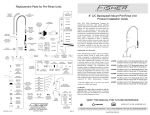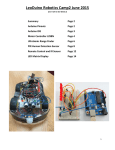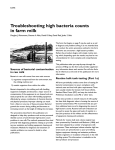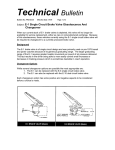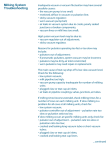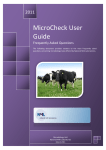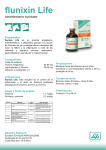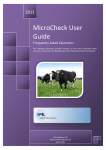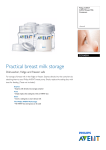Download Milk Quality & Mastitis - troubleshooting, control program
Transcript
Milk quality & mastitis - troubleshooting, control program Jim Reynolds, DVM, MPVM University of California, Davis Tulare Veterinary Medicine Teaching and Research Center 18830 Road 112 Tulare, CA 93274 [email protected] Milk quality and mastitis are separate but very interrelated areas on a dairy. Milk quality refers to specific parameters in the saleable milk – in this case, somatic cell count (SCC), total bacteria count or standard plate count (SPC), coliform count and laboratory pasteurized bacteria count (LPC). Other milk quality issues such as flavors in milk and milk components will not be considered in this discussion. Milk quality is directly affected by mastitis and also by milk equipment sanitation and milk storage and handling. This discussion will focus on the effects of mastitis on milk quality and controlling mastitis to improve milk quality. Mastitis in cattle is defined as inflammation in the mammary tissue, usually caused by bacterial infection. There are many factors associated with infection of the mammary gland and controlling mastitis is one of the main management areas on a dairy. A mastitis program on any dairy has basically two components: • Preventing new infections • Doing something about a mastitis infection when it does happen Because mastitis is caused by bacteria after they get into the udder, it is clear that controlling mastitis should be focused on keeping bacteria out of the mammary gland. It is essential to have good knowledge of the ecology of the bacteria that cause mastitis to recognize how to reduce mastitis infections on the dairy. The bacteria that cause mastitis can be listed in two groups: contagious pathogens and environmental pathogens. It is very useful to categorize mastitis pathogens into these two groups because it facilitates discussion and the groupings direct us to appropriate control measures. Contagious mastitis is controlled by using contagious control procedures in the milking parlor (identifying and segregating infected cows and keeping the milk from each cow away from the teat ends of other cows) and by post-milking teat dipping. Environmental mastitis is controlled by reducing the amount of bacteria at the teat end when the machine is attached. In general, contagious mastitis is often seen as subclinical infections and herd SCC between 300,000 and 500,000 and environmental mastitis is usually clinical, with sudden spikes in the SCC for cows or the bulk tank. Contagious pathogens are from within the cow’s mammary gland and are spread from cow-to-cow during the milking process in the milking parlor. Environmental pathogens Western Dairy Management Conference 1 get on the cow’s teat skin from the dirt and manure the cow lies on and generally are not spread from cow-to-cow during milking. Contagious mastitis pathogens are controlled by identifying infected cows from milk samples and either treating, segregating or culling the infected cows. People milking the cows must follow contagious control procedures such as using separate towels to clean and dry cows and washing their hands after getting any milk on their hands. Environmental mastitis pathogens are controlled by keeping the cow’s environment clean and dry and by sanitizing the cow’s teats prior to milking. This grouping is very useful in understanding how to prevent and control mastitis. Mastitis pathogens are grouped as follows: Contagious Staphylococcus aureus (coagulase positive staphylococcus) Streptococcus agalactia Mycoplasma Environmental Coliform (eg: E. coli) Streptococcus uberus and dysgalactia Staphylococcus species (coagulase negative staphylococcus) It is imperative that the cow’s teats be cleaned and dried before the milking machine is attached. Bacteria on the skin of the cow’s teats and udder are likely to enter the teat through the teat sphincter during milking and cause mastitis. The end of the cow’s teat, the teat sphincter, is the cow’s primary defense mechanism against mastitis infections. The main goal of mastitis prevention is to keep bacteria away from the cow’s teat end before, during and after milking. There are many factors involved in preventing and controlling mastitis infections. For the contagious pathogens, the first step is to identify infected cows. Staph. aureus and mycoplasma can be brought into the herd with purchased cattle or fresh heifers. Both Staph. aureus and mycoplasma have reservoirs outside the mammary gland and therefore cows can develop Staph. aureus and mycoplasma mastitis from themselves. Mycoplsama exists as a commensal organism in many cows; that is, the bacteria lives in the lungs or the reproductive tract without causing clinical disease. It can recrudesce, or flair up, and go to the mammary gland and cause mastitis at anytime. Staph. aureus is mostly an udder pathogen, but there are some cows with the mastitis strain of Staph. aureus on their skin. These out of the mammary gland reservoirs can provide bacteria for new infections. The control of the contagious mastitis pathogens requires in large herds requires routine sampling of the milk of all purchased cows and all clinical cases to detect the presence of Staphylococcus aureus, Streptococcus agalactia, or mycoplasma. It is recommended that that cows infected with Staphylococcus aureus or mycoplasma are culled immediately because these pathogens do not respond to treatment and infected cows will serve as reservoirs to infect other cows during the milking process. Cows infected with Streptococcus agalactia can be successfully treated and kept in the herd. If purchased March 7-9 Reno, NV 2 cows are not sampled for the contagious mastitis pathogens there is a probability that some will be infected and the organisms will spread in the herd. The second main step in controlling contagious mastitis is to use individual towels to clean and dry cows prior to milking. Using a towel between several cows risks taking bacteria from the teat end of one cow to the teat ends of other cows. The hands of the milkers must be kept clean of any milk that gets on the hands during the milking process. The final step in prevention of contagious mastitis pathogens is to dip the cow’s teats after milking with an approved post-milking teat dip. This is because Staphylococcus aureus and Streptococcus agalactia can be at the teat end after milking and can colonize the tissue and invade up through the teat sphincter and into the mammary gland. Properly dipping the teat after milking kills these bacteria and can reduce the new infection rate with contagious pathogens. The post-milking teat dip should have an emollient system in it to maintain the integrity, or health, of the teat skin. This is very important on dry-lot dairies during the winter when cow’s teats can be expected to be exposed to wind, rain, mud and manure. The teats can become chapped and crack under these conditions. This can be painful to the cow and she may not let her milk down when the machine is attached in the parlor due to the discomfort. The post-milking teat dip must be selected to maintain the health of the teat skin during different times of the year. The environmental pathogens essentially come from the environment the cow lives and lies down in and therefore are best controlled by keeping the cow housing clean and sanitary. Cows lying in manure, mud and water will have more environmental bacteria on their udder and teat skin when they enter the milking parlor and therefore will be at higher risk of having the bacteria enter through the teat sphincter and cause mastitis. The first step in controlling environmental mastitis, then, is to keep the corrals clean and dry. The procedures at the milking parlor can only clean a small amount of manure, dirt and bacteria from the udder and teats. Wash pens are often necessary to remove the majority of the manure. It is absolutely necessary that cows’ teats and udders be clean and dry before the machine is attached to control mastitis. It is sometimes recommended that the cows’ teats be dipped with an approved disinfectant prior to milking and that this pre-dip be wiped off before the machine is attached. Pre-dipping can help clean the teats and help decrease cases of environmental mastitis. A very important part of mastitis control on dairies is the detection of clinical cases. The milkers must be trained to detect cows with mastitis, hold or separate them from the rest of the pen, and the cows must be treated, segregated or culled. Cows with clinical mastitis have inflammation in the mammary gland (heat, swelling, pain) and changes in the milk (watery milk or clumps of protein). If cows with clinical mastitis are not detected and taken care of correctly, the infections are likely to become sub-clinical. Sub-clinical infections are not detectable by observation of the milk and cows with subclinical infections from contagious pathogens will serve as reservoirs of bacteria to infect other cows during the milking process. It is commonly recommended that all clinical cases have milk samples taken and cultured by a mastitis laboratory to detect any cows with contagious pathogens. Western Dairy Management Conference 3 Because mastitis is inflammation in the mammary gland, the products of inflammation can be used to monitor mastitis in cows and the herd. The most common method to monitor inflammation in the mammary gland of cattle is to measure the somatic cell count (SCC). The somatic cells in the mammary gland are mostly white blood cells (neutrophils) and the SCC increases during infection. The amount and time of increase in SCC depends on the type of bacteria causing the mastitis, the cow’s immune system and the chronicity of the infection. The relationship of the level of SCC in a cow or in the herd to infection and management can be described as: Somatic Cell Count = the new infection rate X duration of infection For example: if no cows on a dairy get mastitis, the SCC will be low. If all the cows get mastitis but are detected immediately and treated perfectly, the SCC will be low. If cows get mastitis but the cases are not detected or treated appropriately the SCC will be high. This simple equation exemplifies the fact that the dairy must do all it can to prevent mastitis (keeping the cows clean and dry, finding the cows with contagious pathogens) and also must detect the cases that do happen quickly and treat, segregate or cull the new cases appropriately. The following summary of factors associated with mastitis is taken from Sears et al, Procedures for mastitis diagnosis and control, in The Veterinary Clinics of North America, Food Animal Practice, Update on Bovine Mastitis, November 1993, page 448: Environmental organisms (usually clinical) Coliforms, Strep. species, Staph. species Associated factors: -- clean/dry bedding -- clean udders -- premilking udder preparation -- proper milking procedure -- milking machine maintenance -- dry cow management -- adequate vitamin E/selenium Contagious organisms (usually high SCC) Staph. aureus, Strep. agalactia, (also mycoplasma) Associated factors: -- proper milking procedures -- milking machine maintenance -- teat dipping -- maintain closed herd -- culture purchased animals There are two basic ways to know if your herd has too much mastitis: the mastitis case rate and somatic cell counts. The mastitis case rate is the more sensitive measure if cases March 7-9 Reno, NV 4 are being detected early because SCC increases, for most bacterial mastitis, as the infection progresses and because individual cow SCC is reported only once per month at test day. The California Mastitis Test can be used on suspect cows at milking to improve the detection of mastitis. It is commonly advised that there should be fewer than 3% of cows in the herd in the hospital pen with mastitis and waiting for antibiotic withdrawal, or less than 1% of the herd with mastitis on any day. A normal mammary gland has 200,000 SCC/ml of milk or less. Above 200,000 is considered inflamed and therefore infected. Individual test day SCC can be graphed by most dairy software programs to determine the number, or proportion, of cows without infections, with new infections, recovered from infections or having chronic infections (current SCC by last test SCC). This can help the dairy determine how well mastitis is being detected and treated. Less than 10% of the herd should have high SCC in both the current test SCC and the previous test SCC. If more than 10% is in this area either cows with mastitis are not being detected (poor detection by the milkers), the herd has a high rate of subclinical mastitis (possible contagious mastitis problem), or cases are not being held out and treated properly. Mastitis control on large dairies should be thought of as a system that provides clean and dry housing, moves cows into and out of the milking parlor calmly, sanitizes the udder before the machine is attached, detects mastitis quickly and treats or culls cows with mastitis promptly. Cows should be routinely sampled and screened for contagious mastitis and the herd SCC used to monitor the level of inflammation in the herd and the detection and responses to treatment. Western Dairy Management Conference 5






